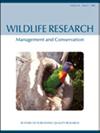Habitat structure facilitates coexistence of native and invasive mesopredators in an Australian tropical savanna
IF 1.6
3区 生物学
Q3 ECOLOGY
引用次数: 0
Abstract
ABSTRACT Context. The introduction of the cat (Felis catus) to Australia has been a key driver of the decline and extinction of the continent’s endemic mammals. Currently, there is no clear long-term solution to controlling feral populations of cats at a landscape scale. As such, understanding how environmental conditions and habitat attributes can mediate the coexistence between introduced predators and native mammals can improve management outcomes for threatened species. Aims. We sought to compare the differences in habitat use by feral cats and a remnant population of the endangered northern quoll (Dasyurus hallucatus) to understand what environmental variables allow these two mesopredators to coexist in tropical savanna of Cape York Peninsula, Queensland. Methods. We deployed grids of motion-activated cameras three times per year over a 3-year period, across Eucalyptus tetrodonta-dominated plateaux known to be inhabited by feral cats and northern quolls. We modelled the spatial variation in the frequencies of detection of feral cats and northern quolls (referred to as ‘habitat use’), as a function of biotic and abiotic environmental variables by using a generalised linear model for consistent variables and a generalised linear mixed-effect model for fluctuating variables. Key results. Habitat use by feral cats was most frequent in areas with high fire frequencies and low tree basal area, whereas habitat use by northern quolls was most frequent in areas of high basal area of E. tetrodonta (a commonly used den tree species), topographic ruggedness, and long-unburnt savanna. Conclusions. Frequent fires in tropical savanna promote habitat use by feral cats and can result in a reduction of critical habitat for northern quolls. Implications. We postulate that remnant populations of northern quolls on Cape York Peninsula occur in less frequently burnt refugia, primarily on top of plateaux that support high-biomass tropical savanna dominated by E. tetrodonta. Our findings highlighted that threatened mammals can persist alongside introduced predators in tropical savanna but are dependent on the maintenance of structurally complex habitat.澳大利亚热带稀树草原的栖息地结构促进了本土和入侵中掠食者的共存
本文章由计算机程序翻译,如有差异,请以英文原文为准。
求助全文
约1分钟内获得全文
求助全文
来源期刊

Wildlife Research
生物-动物学
CiteScore
4.30
自引率
15.80%
发文量
56
审稿时长
3 months
期刊介绍:
Wildlife Research represents an international forum for the publication of research and debate on the ecology, management and conservation of wild animals in natural and modified habitats. The journal combines basic research in wildlife ecology with advances in science-based management practice. Subject areas include: applied ecology; conservation biology; ecosystem management; management of over-abundant, pest and invasive species; global change and wildlife management; diseases and their impacts on wildlife populations; human dimensions of management and conservation; assessing management outcomes; and the implications of wildlife research for policy development. Readers can expect a range of papers covering well-structured field studies, manipulative experiments, and analytical and modelling studies. All articles aim to improve the practice of wildlife management and contribute conceptual advances to our knowledge and understanding of wildlife ecology.
Wildlife Research is a vital resource for wildlife scientists, students and managers, applied ecologists, conservation biologists, environmental consultants and NGOs and government policy advisors.
Wildlife Research is published with the endorsement of the Commonwealth Scientific and Industrial Research Organisation (CSIRO) and the Australian Academy of Science.
 求助内容:
求助内容: 应助结果提醒方式:
应助结果提醒方式:


